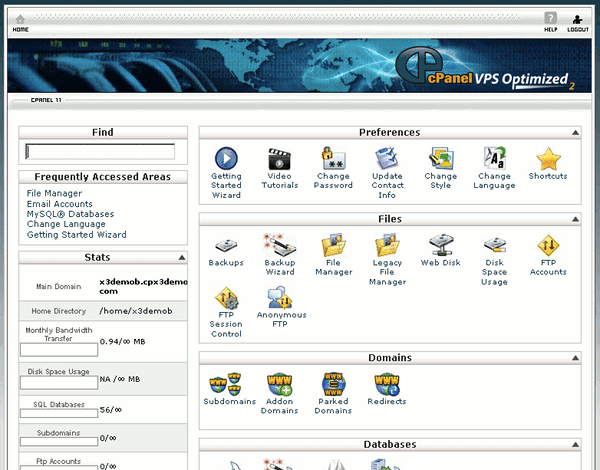Web Hosting Control Panels
cPanel (which stands for "control panel") is the world's most popular web hosting control panel. cPanel allows webmasters to maintain their web server and website via a graphical user interface (GUI).
Created by J. Nick Koston originally for the web host, Speed Hosting, it was then passed along to a hosting facility, Virtual Development Inc. An exclusive contract was established such that only those who were hosted by VDI had access to cPanel. Eventually, the need for and utility of web hosting control panels were recognized and cPanel is now widely available, provided by many hosting companies.
Other web hosting control panels have been developed (Plesk, Direct Admin), but cPanel remains the most popular.
The reason for cPanel's popularity is because it's well-developed and updated regularly. cPanel has been fine-tuned, developing different versions to accommodate for different types of users: shared hosting accounts, VPS and dedicated. They additionally created a webtool, WebHost Manager (WHM), for server administrators and resellers. Regardless of the type of site you're running, there is a cPanel for you. As a result, a large cPanel community has formed, producing many tutorials and forums to support and teach one another how to most effectively use the platform.
What Does cPanel Look Like?
Below is a screenshot of cPanel. As you can see, the GUI makes it quite intuitive to user.

cPanel Features
You can modify pretty much anything on your site with just a few clicks on cPanel. Creating and maintaining a website is now more manageable and intuitive, even allowing novices into this technical world. The following are some cPanel highlights.
Compatibility
When building a site, there are now many options in web server software, database management systems, and content management systems. cPanel is versatile and supports most of these applications used throughout the creation and maintenance of a website (such as Apache, MySQL, and PHP of the popular LAMP bundle).
cPanel allows you to configure email accounts, supporting POP3, IMAP, and SMTP. It's also simple to manage mailing lists and add a new email account or edit one out.
File managing
cPanel simplifies file management. You can design your site on another program (such as Dreamweaver) and upload the files onto cPanel, which will then be displayed on the internet. Alternatively, you can use a template (such as a WordPress theme). Regardless of how you go about developing your site, cPanel makes it easier for you to manage whatever files you want to be on your site.
Add-ons
There have been a lot of add-ons developed so web hosts can personalize their customers' cPanel experience in order to better suit their needs. However, the hosting companies usually have to pay for these. One of the most notable of these add-ons is Fantastico, a commercial script library that automates the installation of over 50 web applications.
Other features
cPanel also allows you to easily access and manage:
- PGP keys
- FTP users' accounts
- Server logs
- Databases
- Additional domains
Summary
A web hosting control panel is powerful tool. Without it, the internet would be a dark place, as fewer people would be able to directly communicate with and develop on the server.
Providing you with a graphical interface to modify the server, a control panel transforms website management from a tedious obstacle course to an effortless task. cPanel is a promising choice in control panels — it's easy to use, flexible, and has a large and supportive following. If you're in the market, see which webhosts provide cPanel and give it a spin! You'll be pleased with how simple it is to manage a website.
This article was provided by Nina Wu of A Small Orange web hosting.